Impact of Hands-on Activities on Vocabulary Skills in ESL Learners
VerifiedAdded on 2023/06/15
|5
|768
|261
Essay
AI Summary
This essay examines the impact of hands-on activities on vocabulary learning for second-grade ESL learners. The introduction highlights the importance of vocabulary in language acquisition and the difficulties students face in learning new words. The research problem identifies the challenges students encounter in remembering new vocabulary, suggesting potential issues with teaching techniques or cognitive deficits. The study aims to investigate the effects of implementing hands-on activities to improve vocabulary skills, addressing research questions about the relationship between these activities and student achievement. The essay concludes with a list of references used to support the research.
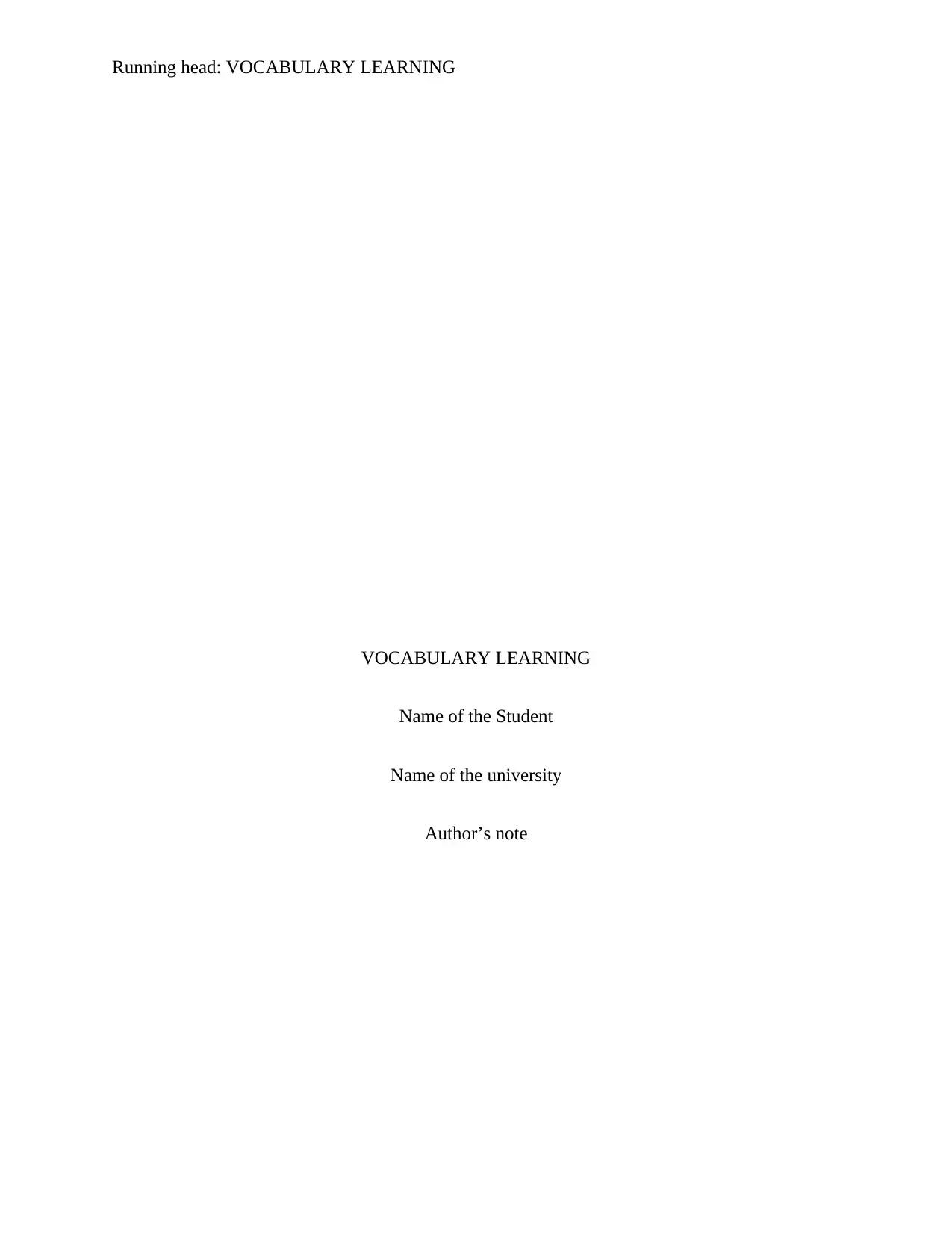
Running head: VOCABULARY LEARNING
VOCABULARY LEARNING
Name of the Student
Name of the university
Author’s note
VOCABULARY LEARNING
Name of the Student
Name of the university
Author’s note
Paraphrase This Document
Need a fresh take? Get an instant paraphrase of this document with our AI Paraphraser
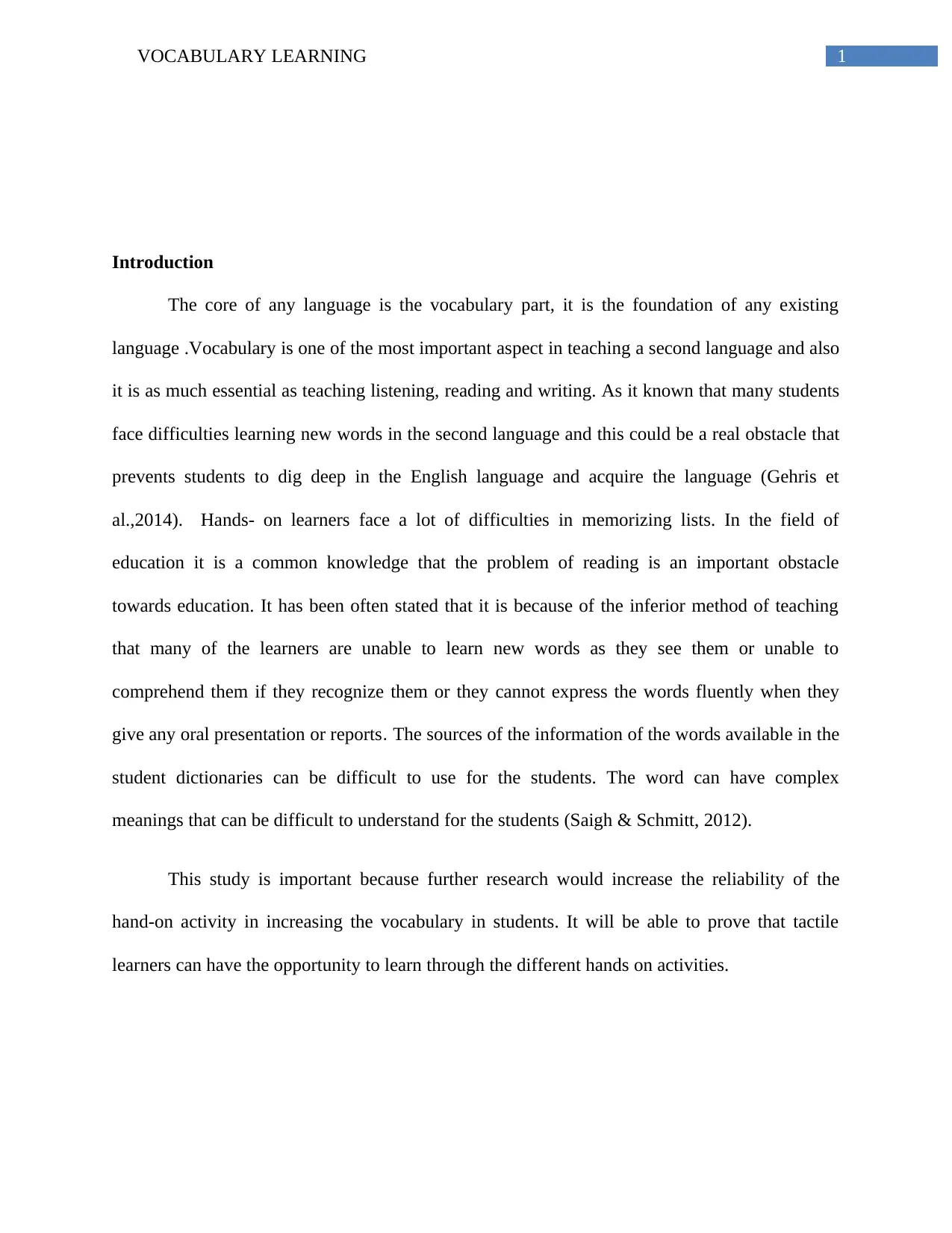
1VOCABULARY LEARNING
Introduction
The core of any language is the vocabulary part, it is the foundation of any existing
language .Vocabulary is one of the most important aspect in teaching a second language and also
it is as much essential as teaching listening, reading and writing. As it known that many students
face difficulties learning new words in the second language and this could be a real obstacle that
prevents students to dig deep in the English language and acquire the language (Gehris et
al.,2014). Hands- on learners face a lot of difficulties in memorizing lists. In the field of
education it is a common knowledge that the problem of reading is an important obstacle
towards education. It has been often stated that it is because of the inferior method of teaching
that many of the learners are unable to learn new words as they see them or unable to
comprehend them if they recognize them or they cannot express the words fluently when they
give any oral presentation or reports. The sources of the information of the words available in the
student dictionaries can be difficult to use for the students. The word can have complex
meanings that can be difficult to understand for the students (Saigh & Schmitt, 2012).
This study is important because further research would increase the reliability of the
hand-on activity in increasing the vocabulary in students. It will be able to prove that tactile
learners can have the opportunity to learn through the different hands on activities.
Introduction
The core of any language is the vocabulary part, it is the foundation of any existing
language .Vocabulary is one of the most important aspect in teaching a second language and also
it is as much essential as teaching listening, reading and writing. As it known that many students
face difficulties learning new words in the second language and this could be a real obstacle that
prevents students to dig deep in the English language and acquire the language (Gehris et
al.,2014). Hands- on learners face a lot of difficulties in memorizing lists. In the field of
education it is a common knowledge that the problem of reading is an important obstacle
towards education. It has been often stated that it is because of the inferior method of teaching
that many of the learners are unable to learn new words as they see them or unable to
comprehend them if they recognize them or they cannot express the words fluently when they
give any oral presentation or reports. The sources of the information of the words available in the
student dictionaries can be difficult to use for the students. The word can have complex
meanings that can be difficult to understand for the students (Saigh & Schmitt, 2012).
This study is important because further research would increase the reliability of the
hand-on activity in increasing the vocabulary in students. It will be able to prove that tactile
learners can have the opportunity to learn through the different hands on activities.
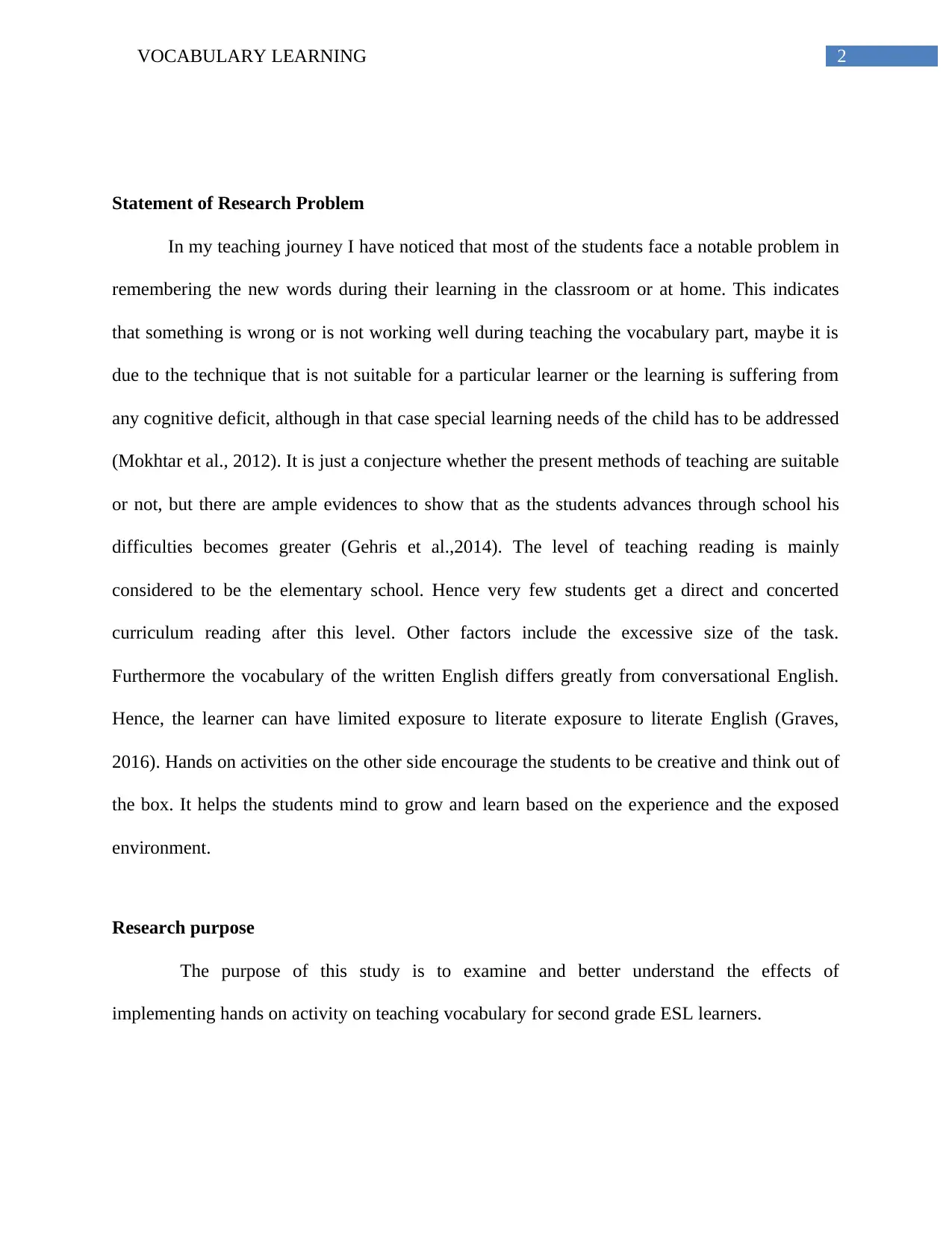
2VOCABULARY LEARNING
Statement of Research Problem
In my teaching journey I have noticed that most of the students face a notable problem in
remembering the new words during their learning in the classroom or at home. This indicates
that something is wrong or is not working well during teaching the vocabulary part, maybe it is
due to the technique that is not suitable for a particular learner or the learning is suffering from
any cognitive deficit, although in that case special learning needs of the child has to be addressed
(Mokhtar et al., 2012). It is just a conjecture whether the present methods of teaching are suitable
or not, but there are ample evidences to show that as the students advances through school his
difficulties becomes greater (Gehris et al.,2014). The level of teaching reading is mainly
considered to be the elementary school. Hence very few students get a direct and concerted
curriculum reading after this level. Other factors include the excessive size of the task.
Furthermore the vocabulary of the written English differs greatly from conversational English.
Hence, the learner can have limited exposure to literate exposure to literate English (Graves,
2016). Hands on activities on the other side encourage the students to be creative and think out of
the box. It helps the students mind to grow and learn based on the experience and the exposed
environment.
Research purpose
The purpose of this study is to examine and better understand the effects of
implementing hands on activity on teaching vocabulary for second grade ESL learners.
Statement of Research Problem
In my teaching journey I have noticed that most of the students face a notable problem in
remembering the new words during their learning in the classroom or at home. This indicates
that something is wrong or is not working well during teaching the vocabulary part, maybe it is
due to the technique that is not suitable for a particular learner or the learning is suffering from
any cognitive deficit, although in that case special learning needs of the child has to be addressed
(Mokhtar et al., 2012). It is just a conjecture whether the present methods of teaching are suitable
or not, but there are ample evidences to show that as the students advances through school his
difficulties becomes greater (Gehris et al.,2014). The level of teaching reading is mainly
considered to be the elementary school. Hence very few students get a direct and concerted
curriculum reading after this level. Other factors include the excessive size of the task.
Furthermore the vocabulary of the written English differs greatly from conversational English.
Hence, the learner can have limited exposure to literate exposure to literate English (Graves,
2016). Hands on activities on the other side encourage the students to be creative and think out of
the box. It helps the students mind to grow and learn based on the experience and the exposed
environment.
Research purpose
The purpose of this study is to examine and better understand the effects of
implementing hands on activity on teaching vocabulary for second grade ESL learners.
⊘ This is a preview!⊘
Do you want full access?
Subscribe today to unlock all pages.

Trusted by 1+ million students worldwide
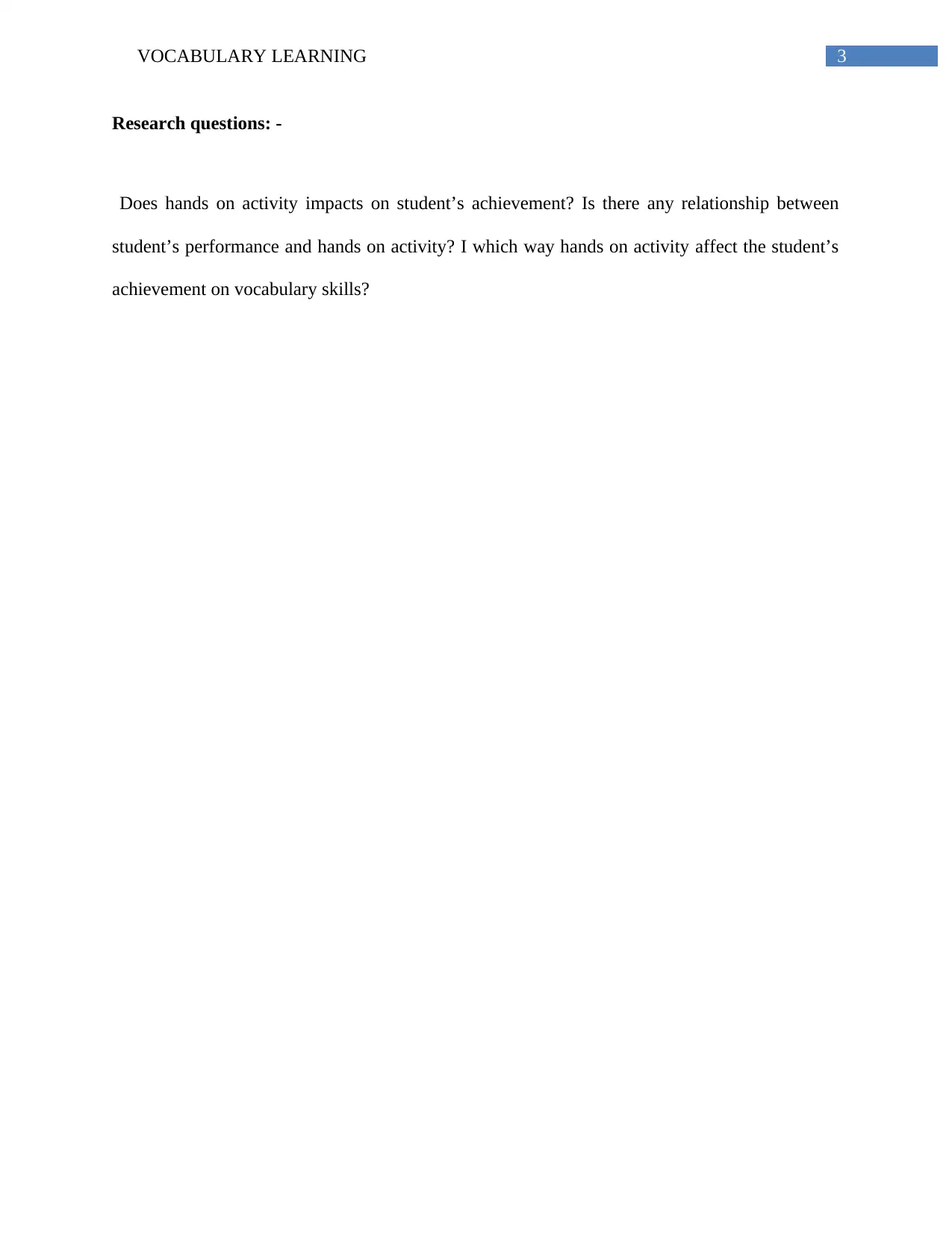
3VOCABULARY LEARNING
Research questions: -
Does hands on activity impacts on student’s achievement? Is there any relationship between
student’s performance and hands on activity? I which way hands on activity affect the student’s
achievement on vocabulary skills?
Research questions: -
Does hands on activity impacts on student’s achievement? Is there any relationship between
student’s performance and hands on activity? I which way hands on activity affect the student’s
achievement on vocabulary skills?
Paraphrase This Document
Need a fresh take? Get an instant paraphrase of this document with our AI Paraphraser
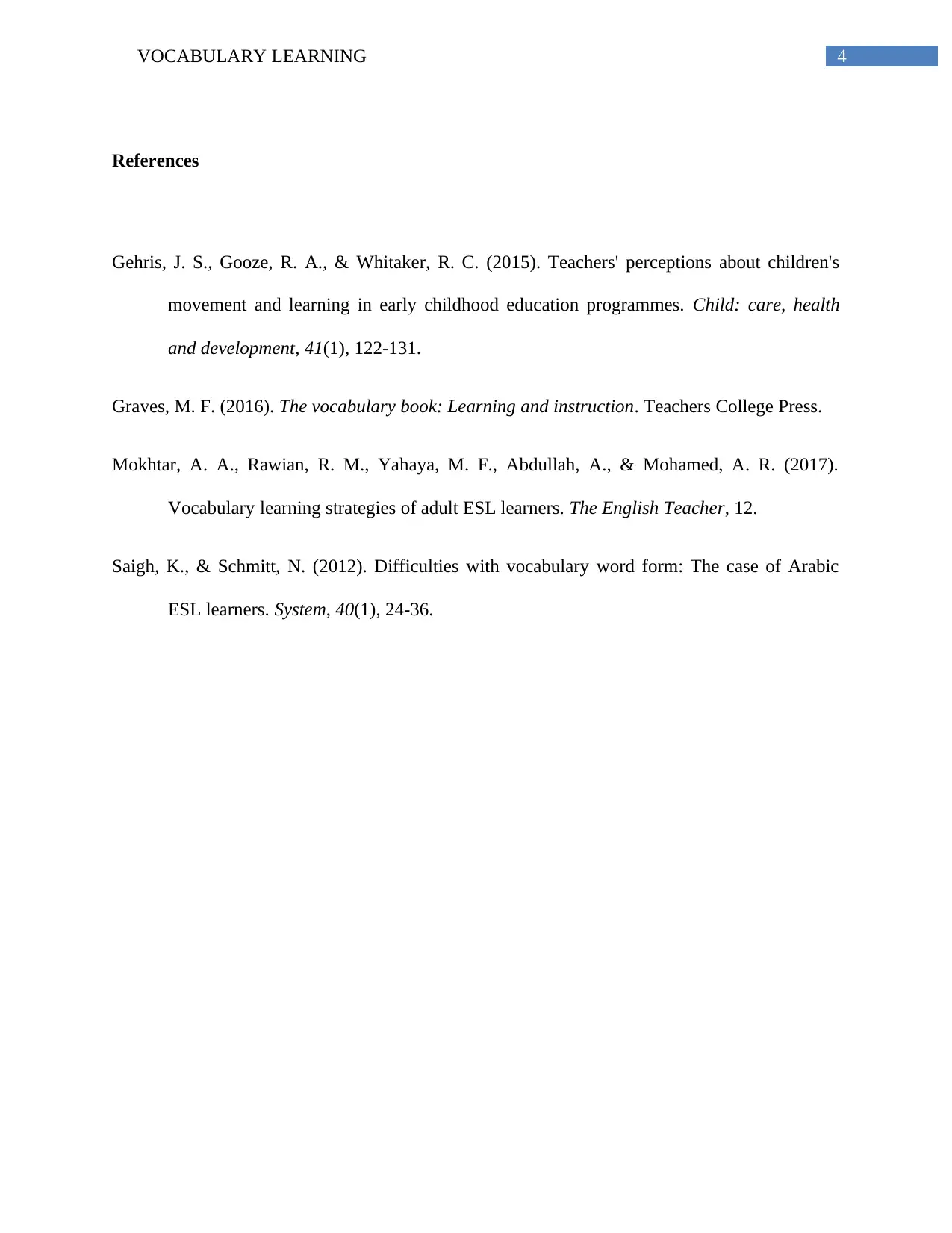
4VOCABULARY LEARNING
References
Gehris, J. S., Gooze, R. A., & Whitaker, R. C. (2015). Teachers' perceptions about children's
movement and learning in early childhood education programmes. Child: care, health
and development, 41(1), 122-131.
Graves, M. F. (2016). The vocabulary book: Learning and instruction. Teachers College Press.
Mokhtar, A. A., Rawian, R. M., Yahaya, M. F., Abdullah, A., & Mohamed, A. R. (2017).
Vocabulary learning strategies of adult ESL learners. The English Teacher, 12.
Saigh, K., & Schmitt, N. (2012). Difficulties with vocabulary word form: The case of Arabic
ESL learners. System, 40(1), 24-36.
References
Gehris, J. S., Gooze, R. A., & Whitaker, R. C. (2015). Teachers' perceptions about children's
movement and learning in early childhood education programmes. Child: care, health
and development, 41(1), 122-131.
Graves, M. F. (2016). The vocabulary book: Learning and instruction. Teachers College Press.
Mokhtar, A. A., Rawian, R. M., Yahaya, M. F., Abdullah, A., & Mohamed, A. R. (2017).
Vocabulary learning strategies of adult ESL learners. The English Teacher, 12.
Saigh, K., & Schmitt, N. (2012). Difficulties with vocabulary word form: The case of Arabic
ESL learners. System, 40(1), 24-36.
1 out of 5
Related Documents
Your All-in-One AI-Powered Toolkit for Academic Success.
+13062052269
info@desklib.com
Available 24*7 on WhatsApp / Email
![[object Object]](/_next/static/media/star-bottom.7253800d.svg)
Unlock your academic potential
Copyright © 2020–2025 A2Z Services. All Rights Reserved. Developed and managed by ZUCOL.





